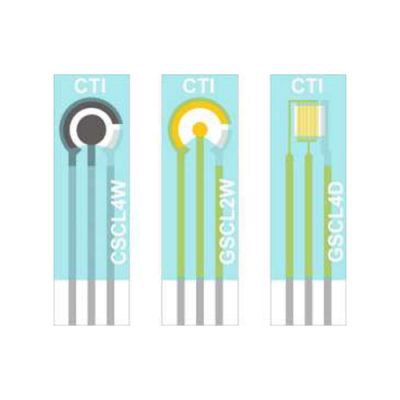CTI Phase Zero Sensors
Phase Zero Sensors support early stage development in the design of an assay for measurement of electrochemical signals between test fluids and a targeted analyte via a potentiostat. These high quality sensors are necessary tools for early stage development projects, enabling scientists and lab technicians to devise testing protocols for identifying electrochemical responses. They support iterative testing of reagent mixtures used in the detection of unique analytes within biological samples.
Materials
These sensors have a PET substrate, with carbon or gold (Au) working and counter electrodes, and a silver/silver chloride (Ag/AgCl) reference electrode along with a printed insulating dielectric. The mating trace leads are designed to interface with common potentiostat accessories as well as banana plugs or alligator clips. The well walls are designed to contain fluids allowing for reagent deposition to perform testing.
Versions
- Carbon working electrode of 2mm diameter
- Gold working electrode of 4mm diameter
- Gold InterDigitated working electrode
For more information, please view the CTI website.

CTI Phase Zero Sensors
Features
- Carbon or Gold CE and WE
- Flexible polyester support material
- Available in commercial volumes
- Ablated and Screen Printed Electrodes
- Overall dimensions: 10mm x 33mm x 0.53mm
- Packed in vials of 25 sensors
- Substrate: White PET base layer
- Silver leads for a more robust connection
- Compatible with common potentiostats
- Customization and scale up available
Specifications
| WE material | Carbon, Gold, Gold InterDigitated |
|---|---|
| Surface modification | Blank |
| Brand | CTI |
| Amount of WEs | 1 |
| CE material | Carbon, Gold |
| Electrode system | CE + RE+ WE |
| Combined RE and CE | No |
| Ø of the disc WE / mm | 2, 4 |
| WE geometric area | 3.14 mm², 12.56 mm² |
| RE material | Silver and Silver Chloride Mixed |
| Support material | Polyester |
| Support dimensions / mm | 10 by 33 |
| Possible analytes | naphthol, dopamine, metals, para-aminophenol, metal complexes, other redox active species |
| Possible applications | Electrolysis, Modifictaion with biomolecules, aryl layers (diazonium chemistry) or similar, Detection of redox active species |
Manufacturers
show DATA — DO NOT CHANGE ID–
Industries
show DATA — DO NOT CHANGE ID–

